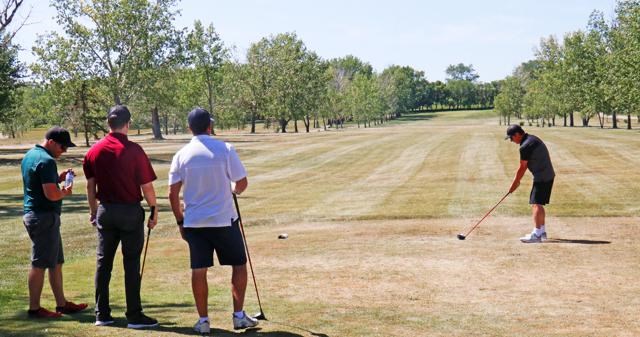A longtime member of the Weyburn Golf Club, Stan Runne, gathered historical records and stories to compile the 100-year history of the golf club, and shared some of the stories with the Weyburn Rotary Club on Thursday at their Zoom meeting.
Among the facts and tidbits he shared, with familiar names of figures from Weyburn’s history, were the reasons why the golf course is located where it is, the challenges members had to get better access to the course, and the fact that there had been a number of smaller golf courses around Weyburn over the years.
The original golf course was on land first owned by John Lloyd in 1906, which was later taken over by the City in 1908, with a reservoir used to impound water from the creek in the area. There were also a number of CPR dams and weirs to dam up water for use by the CP locomotives and for the growing town of Weyburn.
In 1919, the land was sold by the city to the golf club, but at that time there was no Highway 39 — access was only possible from Highway 35, and golfers had to drive 2.5 miles across on a dirt road.
A decade later, the Soo Line Highway was being built from Weyburn to Halbrite, and prominent businessman and Rotary Club member George McCuaig made a push to have a bridge built from this road to the golf course.
“At that time, neither the RM or the province were the least bit interested in providing funds for a golf course bridge,” said Runne, noting that the golf club then formed a bridge committee which began lobbying and raising funds for such a bridge.
CP Rail pulled the tracks out from their rail line in that area, so the golf course proceeded to purchase the right-of-way, and a bridge was built by 1932, with the RM providing a large culvert to cross the Souris River.
“George McCuaig was instrumental in in getting access to the golf club that cut down on a lot of mileage,” said Runne.
In doing his research, he found there was a large gap in records, from 1937 to 1952, because the clubhouse burned down in 1952 after it was struck by lightning, so Runne had to rely on other records to put the story together about the golf club in that time period.
The burned-down clubhouse was replaced by the old Beaver Lumber building, measuring 18 by 24 feet, moved out to the golf course from its location on Fifth Street and Bison Avenue.
At the time the club bought the land for the course in 1919, they revised the constitution of the Wascana Golf Club in Regina and based their first rules and organization, and held their meetings at City Hall. One of their early members, Judge Wood, and others were members of city council at the time, and City Hall was home to golf club executive meetings until 1936.
The golf course early on had sand greens on nine holes, and in 1921 they moved to enlarge them to a 36-foot diameter. In 1927 a veranda was built onto the original clubhouse, and they put up fencing to help keep animals off the course.
A name usually associated with Weyburn’s first rink and pool, Harry Church, was hired in 1933 as the caretaker and manager of the golf club at a wage of $55 a month, plus 25 cents for collecting fees.
There were no trees at the course as such, except for some planted along the riverbanks to help stabilize them, until the PFRA donated trees in 1961, and fairway irrigation was first installed. A tree nursery was began in 1963, and in the 1970s the course expanded with a second set of nine holes.
When the new set of nine holes were opened, Leo Leydon did the ceremonial first drive down the fairway to inaugurate the expansion.
Runne noted the community embraced the sport of golf with a number of smaller six-hole golf courses around the city through the years, including one on South Hill near the old general hospital (later known as the Signal Hill Arts Centre), and another six-hole course was located on the east side of South Hill, between Fifth and 10th Avenues.
A six-hole course, called the Qu’Appelle Golf Course, was located east of King Street and north of First Avenue, with around 2,300 yards of playing north of the present-day Weyburn General Hospital. The teebox for the first hole was located around where Highfield Crescent is today.
Another course, the Jubilee Golf Course, was located on the city’s east side, and this club challenged the Weyburn Golf Club to tournaments in the 1930s. Runne noted that the late Art Wallace made reference to this golf course as being east of the Ashford Grove Tourist Camp, on land from the site of the original swimming pool south to present-day Park Avenue and Seventh Street.
“There were also rumours of a golf course east of Coteau Avenue near Haig School, and Charlie Thompson was supposed to have landed his plane on this golf course one time,” said Runne.
Copies of the history are available from Runne at a cost of $25 each. The book is 273 pages in length in three sections, and includes more recent history, such as information on PGA player Graham DeLaet, and his beginnings at the Weyburn Golf Club.



